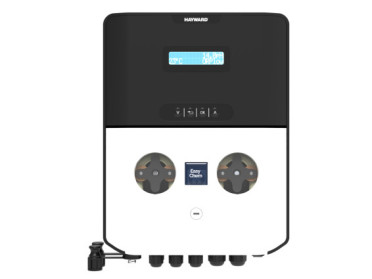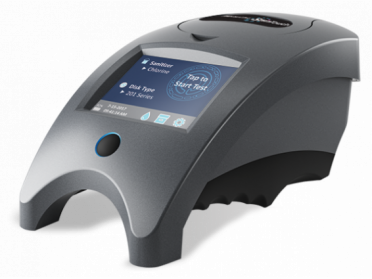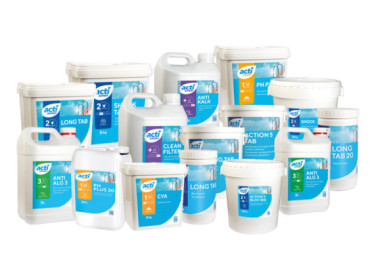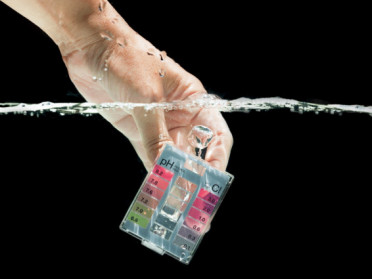
Balanced Water Means a Healthy Swimming Pool
Category : Maintenance
Whether you’ve just gotten your pool, you’re opening your pool for the season, you’re refilling your pool, or you’re performing routine maintenance, establishing the proper chemical balance in your pool water is essential.
A healthy swimming pool depends on you.
Remember, water balance is constantly changing. Even with normal use, unwanted substances find their way into your water. These items can make the water unhealthy or unappealing by preventing chemical treatments from performing optimally. Balancing your pool water and keeping pool chemicals in their ideal ranges will help ensure that your water will not harm your swimming pool or swimmers. So let’s dive right into that basic chemistry!
Introduction to Pool Chemistry
Before you can start to master balancing water levels, you need to understand some of the common terminology concerning the water quality in your inground of above-ground swimming pool.
- pH: This is a measure of how acidic or basic your pool water is. This is calculated in a range from 0 to 14: Less than 7 indicates acidity, 7 indicates a neutral state, and greater than 7 indicates a base. The pH level is an indicator of equilibrium that functions like a scale, measuring how acidic or how basic your water is.
- Total Alkalinity: This measures the concentration of all alkaline substances (bicarbonate, carbonate, and hydroxide ions) dissolved in your pool water, as well as the water’s ability to resist changes in pH. Alkalinity is what neutralizes the acids in your swimming pool water.
- Total Dissolved Solids (TDS): This is combined total of all organic and inorganic substances contained in your pool water. This encompasses everything other than the pure H20 molecules – primarily salts, minerals, metals, cations or anions, and organic matter. TDS is a general indicator of your pool’s water quality.
What Impacts My Pool Water?
Your pool chemistry can be affected by a number of factors. Consider these questions when working on balancing your pool water:
- Water quality: Do you have hard water or soft water?
- Temperature: Do you live in a very hot climate?
- Pool usage: Do you use your pool multiple times each day?
- Swimmer load: Do you have a lot of pool parties?
- Heavy rainfall: Has it been a particularly stormy season?
Why Does pH Balance Matter?
The level of pH in your swimming pool water impacts pretty much everything… from algae growth and corrosion to comfort and cleanliness to the effectiveness of other chemicals in your swimming pool.
Here are some key reasons why you’ll want to make it a point to regulate your pool water’s pH levels:
- Stave off unsightly algae growth and potentially damaging mineral build-up around your pool.
- Prevent corrosion of your pool’s metal components - like ladders, handrails, and pool pump elements – caused by low pH levels
- Avoid eye and skin irritation from pool water with improper pH levels.
- Keep chlorine working effectively to kill off germs and bacteria.
Ideally, you want the pH in your pool water somewhere between 7.2 and 7.8. Pool water outside of these ranges can lead to a variety of complications. If it falls below 7.2, use a pH increaser to balance the water. When it climbs over 7.8, add a pH decreaser.
pH and Saltwater Pools
A saltwater swimming pool has a different chemical makeup than a traditional chlorine pool, and it’s more susceptible to higher pH. If you have salt water, you’ll want to keep a pH decreaser on hand to treat your water whenever your levels escalate.
Why Is Total Alkalinity Important?
Total alkalinity and pH go hand-in-hand: Low-alkaline water leads to low pH, and high-alkaline water leads to high pH. Total alkalinity is measured in parts per million (PPM), which is a measurement of how much of a particular substance – such as a chemical or mineral – is present in water.
pH is extremely sensitive, easily thrown out of balance by temperature changes, rain, debris, and even swimmer waste. Alkalinity adds a layer of armor to your pH, absorbing these fluctuations to maintain stable pool chemistry.
Alkalinity that’s too high or too low plays with pH and can lead to a wide range of issues, from minor skin irritation and red eyes to algae growth and cloudy water. Shoot for a total alkalinity in the range of 80-120ppm, depending on the type of chlorine you use.
Raising alkalinity is as simple as adding a branded alkalinity increaser – or simple baking soda (sodium bicarbonate). Lowering alkalinity requires a substance to bring it back down, either liquid muriatic acid (hydrochloric acid) or dry acid (sodium bisulfate) in granular form.
| Low Alkalinity | High Alkalinity |
| Falling below 80 ppm alkalinity means your water is too acidic, which can cause: | Rising above 120 ppm alkalinity causes your water to be too alkaline, which can cause: |
| Corrosion of pool surfaces and equipment | Scaling of pool surfaces and equipment |
| Etching and staining of pool surfaces and equipment | A high pH level that’s difficult to lower |
| Pool water to turn a shade of green | Pool water to turn cloudy |
| Burning or itching of the eyes and skin | Burning or itching of the eyes and skin |
Why Do I Need to Worry about Total Dissolved Solids?
TDS is a measurement of everything that has dissolved in your swimming pool water. This includes minerals like calcium and sodium that have separated from your pool chemicals, along with dissolved dust, pollen, swimmer waste, and algae remains.
All water, except for distilled water, contains dissolved minerals. As your pool water evaporates over time, minerals left behind become increasingly concentrated. Minerals in the pool water impede the effectiveness of your pool chemicals, allowing build-up and stains a fighting chance. These concentrated deposits can also turn into hard-to-remove stains on your pool walls and floor.
If your pool has a TDS level of 3,000 ppm or more, it’s time to drain out some water and add fresh water.
The Story with Stabilizers
Pool water stabilizer – also known as cyanuric acid or conditioner – preserves the chlorine levels in your pool and protects them from the break-down effects of U.V rays.
Pool stabilizer is available in liquid or powdered form. Be sure to only add what you need. If you don’t use enough, you'll end up using a lot more chlorine. Adding too much will make your chlorine less effective – and you might need to dilute your pool water to bring it back into the ideal 40 ppm-100 ppm range.
Questions?
Related Products
More Maintenance Tips

Maintenance
Pool Care Basics: Pool Water Info and Tips
You can transform your backyard from a boring patch of land to a luxurious retreat with one exciting addition—a swimming pool! Of course, swimming pools aren’t all fun and games. You need to know how to maintain your pool in order to keep it sparkling clean.






